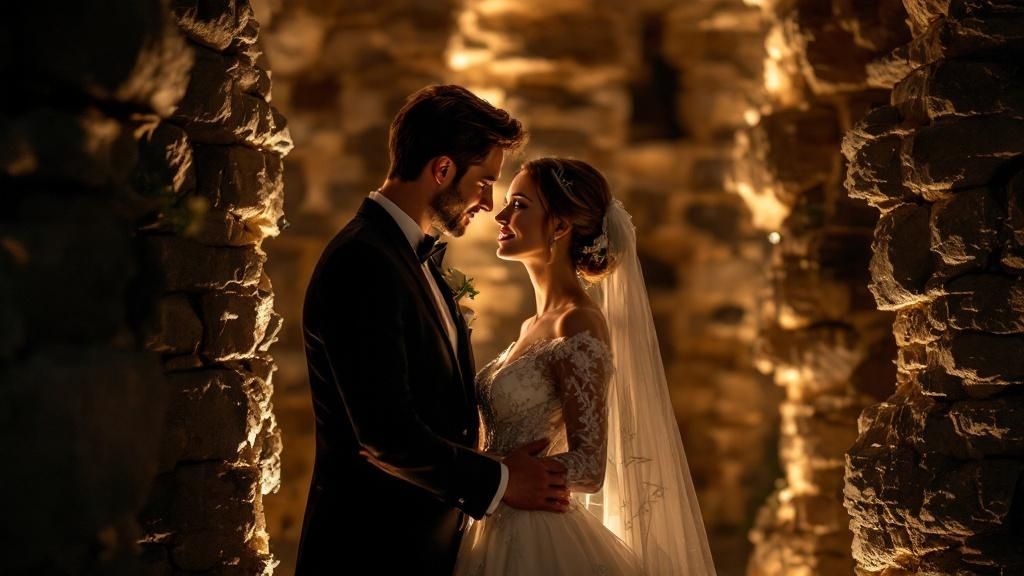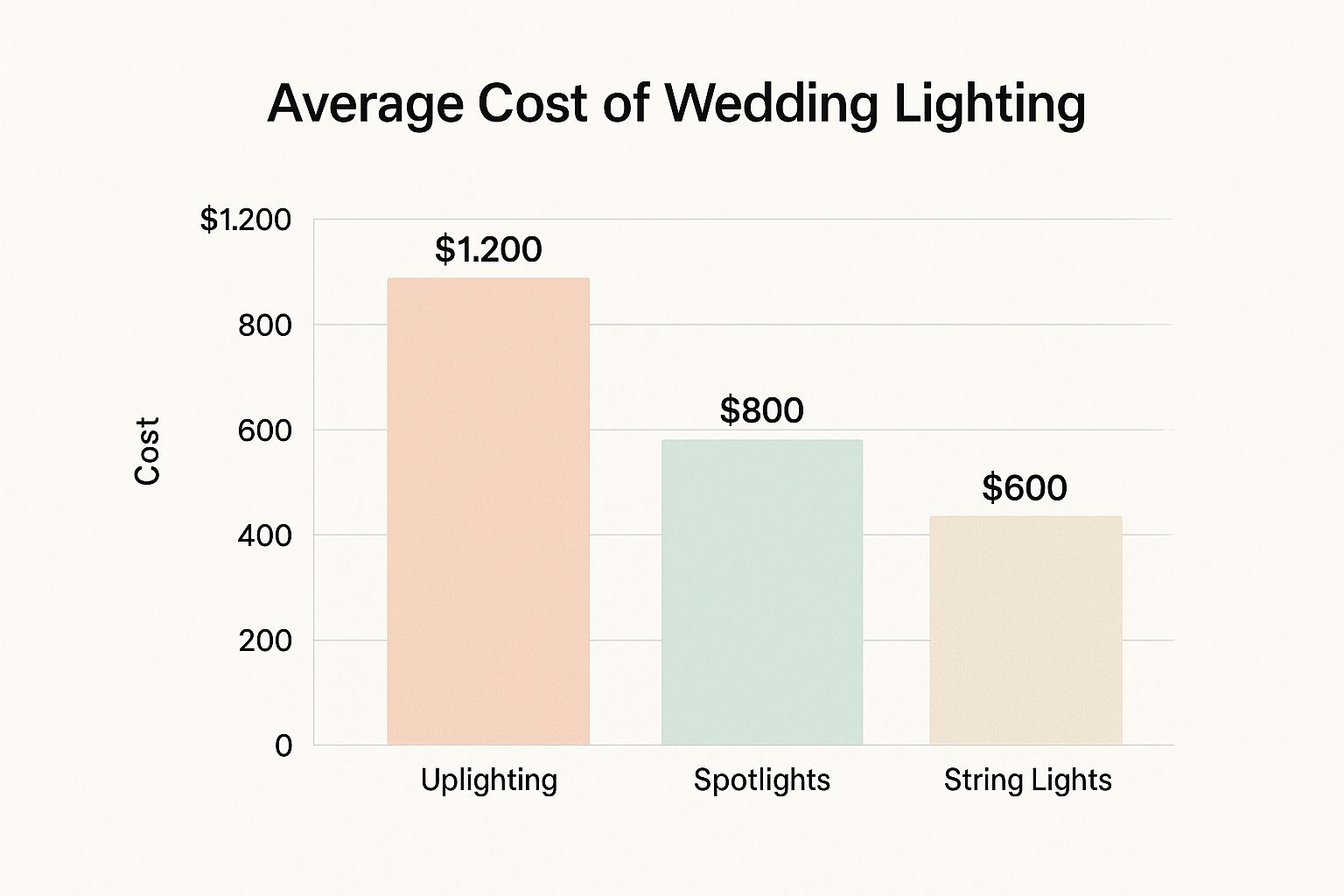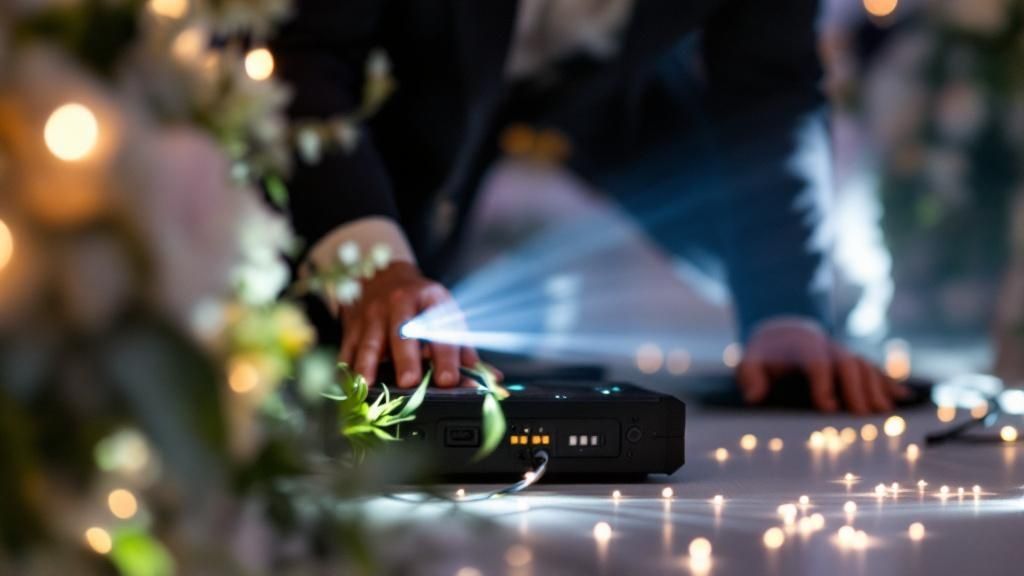Think of your wedding venue as a blank canvas. Now, imagine being able to paint that canvas not with fabric or flowers, but with pure light. That's exactly what uplighting does. It’s the art of placing special light fixtures on the floor and aiming them up, washing walls, columns, and other architectural features in a gorgeous, vibrant glow.
This simple technique completely transforms the entire atmosphere of your celebration, turning a nice room into an unforgettable experience.
What Is Wedding Uplighting and Why It Matters

If your wedding theme is the story, think of uplighting as the mood music—it sets the emotional tone for every single moment. It’s what separates a generic room with bland overhead lighting from an immersive, custom-designed environment that truly feels like you.
Picture a soft, warm amber glow during dinner that makes the space feel intimate and romantic. Later, you can switch to vibrant blues and purples to get everyone on their feet and turn the dance floor into a high-energy party.
What’s incredible is that this one decor element delivers one of the biggest bangs for your buck, often creating a massive visual impact for a fraction of the cost of more elaborate decorations. It just makes everything feel more intentional and professionally designed.
Let's break down the key benefits in a simple way.
Uplighting at a Glance
This table sums up why uplighting is such a game-changer for any wedding venue.
| Key Benefit | What It Means for Your Wedding |
|---|---|
| Creates an Atmosphere | Sets the emotional tone, from a warm, romantic dinner to an energetic dance party. |
| Enhances Your Decor | Makes your flowers, linens, and centerpieces pop and look even more stunning. |
| Adds Depth and Dimension | Prevents a large room from looking flat and boring, adding visual interest everywhere. |
| Improves Photos & Video | Your wedding photos and video will have a professional, dynamic quality that looks amazing. |
Basically, uplighting ties everything together to create a cohesive and beautiful setting.
The Power of Transformation
Uplighting does more than just add a splash of color; it completely redefines the space. By carefully highlighting your venue's best features—like gorgeous columns or intricate ceilings—you can guide your guests' eyes to the details you love. At the same time, you can subtly hide anything you're not a fan of, like a plain wall or an awkward corner.
For couples wanting to get into the nitty-gritty, our guide on what is uplighting for weddings is a great starting point.
Ultimately, uplighting is a powerful tool. It brings warmth, drama, and personality into a room, making sure your wedding day looks and feels exactly how you envisioned it.
Choosing Uplighting Colors to Create Your Vibe
The colors you pick for your uplighting do so much more than just look pretty—they're basically the emotional thermostat for your entire wedding. The right shades can turn a standard ballroom into a space that feels deeply romantic, wildly exciting, or impossibly chic. This is where you get to paint your venue with the exact vibe you’ve been dreaming of.
So, what’s the feeling you're going for? A timeless, romantic evening? Then you'll want to lean into those warm, inviting hues.
Uplighting has the power to completely transform a space and elevate the guest experience. It brings warmth, depth, and energy into a room — creating an immersive atmosphere that feels intentional from the moment guests walk in.
This isn't just a minor detail; it sets the stage for everything, from your vows all the way to the last song of the night.
Colors for a Romantic and Timeless Feel
If you’re aiming for an atmosphere that feels intimate, classic, and warm, a few specific colors work like a charm. These are the shades that make dinner feel cozier, toasts feel more heartfelt, and slow dances feel even more special. Bonus: they make everyone’s skin tones look amazing in photos.
- Amber: This is the undisputed champion of the warm, candlelight glow. It’s incredibly versatile and instantly makes any room feel more intimate and welcoming.
- Soft Pink/Blush: You can't get more romantic than this. A soft pink wash is pure elegance, creating a dreamy vibe that perfectly complements classic decor like white flowers and ivory tablecloths.
- Warm White: Want a look that’s clean and sophisticated without feeling cold or sterile? Warm white is your answer. It beautifully highlights a venue's architecture without screaming for attention.
Think of these colors as the perfect, steady foundation for the early part of your reception. They blend right in with your flowers and table settings, pulling the whole look together.
Colors for a High-Energy Party Vibe
Once the cake is cut and it’s time to hit the dance floor, your lighting should get the memo. This is the moment to switch things up and bring in more vibrant, dynamic colors that tell your guests it’s officially party time. A slow, smooth transition from the warm dinner colors is the key to making it feel natural.
Cooler tones and bold, saturated colors are your best bet for creating that modern, party-all-night atmosphere. These shades are exciting and just make people want to move.
- Cool Blue: This is a super chic and modern choice. It gives the room a sophisticated, cool-in-a-good-way feel that’s perfect for a contemporary party.
- Vibrant Magenta/Purple: Talk about fun and energy. These colors scream "celebration" and look absolutely incredible once the dance floor is packed. They add a touch of drama and regal excitement.
A great lighting pro can even program the lights to sync up and change with the music, creating a mini light show that takes the energy to a whole new level.
To see all the options and get more ideas, check out our full guide on uplighting colors for weddings. By planning a color journey for the night—starting warm and romantic, then shifting to cool and dynamic—you're not just decorating a room; you're guiding the whole emotional experience of your wedding.
Placing Uplights for Maximum Visual Impact
Anyone can stick a few lights on the floor, but strategic placement is what separates an amateur setup from a truly breathtaking design. Where you put your uplights is just as important as the colors you pick.
Think of it this way: your venue is a canvas, filled with all sorts of interesting architectural details. The lights are your highlighters, drawing everyone’s eye to the most beautiful parts of the room. The goal is to turn a regular space into something with depth, drama, and a clear focus. Before you (or your vendor) place a single light, do a slow walk around the venue. What catches your eye?

Identify Your Venue’s Best Features
Every single venue, from a rustic barn to a grand ballroom, has unique features just waiting to be shown off. Your job is to find them and make them shine. Here are a few things to look for:
- Architectural Columns: Putting a light at the base of each column creates this incredible, soaring effect. It instantly makes the room feel taller and more elegant.
- Textured Walls: Got brick, stone, or cool wood paneling? Grazing those surfaces with light brings out all that amazing texture and adds a ton of warmth to the space.
- Dramatic Archways or Windows: You can frame these elements with light to create stunning visual gateways. It just adds a whole other level of grandeur.
- The Head Table or Sweetheart Table: This is your command center for the night! A concentrated wash of light right behind it makes it the undeniable focal point of the reception.
- The Cake Display: A couple of perfectly aimed uplights can transform your wedding cake from just a dessert into a masterpiece.
Creating a Color Wash vs. Pillars of Light
How far apart you space your lights completely changes the vibe. You’re essentially choosing between two distinct looks, and neither one is wrong—it just depends on the atmosphere you want. For a more detailed look at creating the perfect mood, you can explore our full guide on using uplighting at a wedding reception.
Placing lights far apart—think 10-12 feet between each one—creates very distinct "pillars" of light. This gives you a more dramatic, architectural feel, with sharp beams of color shooting up the walls.
Strategic uplight placement is about more than just lighting a room—it’s about sculpting the space with light to tell a story and guide the emotional experience of the evening.
On the other hand, if you place the lights much closer together, say 5-8 feet apart, the beams merge. This creates a seamless and continuous "color wash" that bathes the entire wall in a soft glow. This is the go-to technique for completely immersing the room in your wedding colors, making the whole space feel cohesive and warm.
Knowing the difference between these two approaches means you can guide your lighting vendor with confidence or even tackle a DIY setup like a pro. It ensures every single light is working to make your venue look its absolute best.
Breaking Down the Real Cost of Wedding Uplighting
Alright, let's talk about the money part. You see those breathtaking wedding photos with perfectly lit rooms and probably wonder, "What does that actually cost?" The price for wedding uplighting isn't a simple, one-size-fits-all number. It’s a mix of a few key things that all add up to the final quote.
Getting a handle on these variables will help you make sense of what vendors are offering and understand exactly where your money is going. A basic package might just add a touch of color and elegance, while a full-blown venue transformation is, naturally, going to be a bigger investment.
Here's a quick look at how different lighting options stack up against each other.

You can see that while uplighting might seem like a bigger spend upfront, its ability to completely change a room often gives you the most dramatic result for your dollar.
What Goes Into Your Quote?
So, what makes the price swing one way or the other? It almost always boils down to a handful of core components that lighting pros use to build their packages. Knowing what they are will make your conversations with them a lot more productive.
- How Many Lights You Need: This is the most straightforward factor. A huge ballroom that you want to drench in color is going to need a lot more lights than a smaller space where you just want to accent a few columns or the head table.
- The Type of Fixtures (Wired vs. Wireless): These days, wireless, battery-powered LED lights are pretty much the gold standard. They look so much cleaner without cables running everywhere and can be placed in tricky spots. They do, however, usually cost a bit more to rent than older, wired lights.
- Your Venue's Size and Layout: A massive room with soaring ceilings, intricate pillars, and lots of nooks and crannies will require a more complex (and pricier) setup than a simple, open-plan space.
- Having a Pro On-Site: Many premium packages include a dedicated lighting technician who stays for the whole event. This person is your go-to for changing colors to match the vibe—say, from a soft amber during dinner to a vibrant magenta for dancing—and for fixing any glitches on the spot. It's a huge stress-reliever and often worth every penny.
Thinking About It as an Investment
Instead of seeing lighting as just another line item on the bill, think of it as an investment in your wedding's entire atmosphere. There's a reason the global wedding services market is expected to hit around USD 641.00 billion by 2032—couples want a day that feels uniquely theirs. High-impact decor like lighting is a massive part of that.
When it comes to "bang for your buck," uplighting is a serious contender. It can take a perfectly nice but plain room and make it look like a high-end, custom-designed event space. It truly elevates the entire feel of your celebration.
At the end of the day, uplighting pays for itself by completely transforming the vibe of your venue. If you want to dive deeper into how this works, you can learn more about using uplighting for wedding receptions right here.
DIY Uplighting vs Hiring a Professional

This is one of the biggest questions couples wrestle with when planning their wedding lighting. Do you rent some lights and go it alone, or is it better to bring in a pro? Honestly, there are good reasons for both, and the right call really boils down to your budget, your comfort level with tech, and how hands-on you want to be on the big day.
The DIY route can definitely be tempting, mostly because you can save some cash. You also get total creative freedom, which is great! For a simple room and a straightforward setup, it can work out perfectly.
But let's be real—it's more than just plugging in a few lights and calling it a day. You’ll be the one picking up the gear, figuring out where everything should go, running and taping down cables, and fixing anything that goes wrong. That's a hefty addition to your to-do list on an already jam-packed day.
The Value of a Professional Touch
Hiring a professional lighting company isn't just about getting better equipment; it's about buying yourself peace of mind. A pro brings a level of design expertise you just can't get from watching a few online tutorials. They know how to look at a venue's architecture—its pillars, arches, and unique features—and design a lighting plan that makes it all pop.
Plus, the pros use high-end, battery-powered wireless lights. This means no ugly cables for your guests to trip over and the freedom to place lights literally anywhere for the best possible effect. This kind of advanced LED tech is a big deal; the broader stage lighting market was valued at USD 2.52 billion back in 2022, showing just how much people want these top-tier, custom experiences.
Most importantly, they handle everything. From setup before the first guest arrives to breakdown after the last dance. If a light starts to flicker mid-reception, they’re on it, leaving you free to actually enjoy the party you spent so much time planning.
DIY vs. Professional Uplighting Comparison
So, you're at a crossroads. Do you roll up your sleeves and DIY, or do you call in the experts? This little table breaks down the key differences to help you figure out which path feels right for your wedding.
| Factor | DIY Approach | Professional Service |
|---|---|---|
| Cost | Lower initial cost, typically just rental fees. | Higher upfront investment for expertise, equipment, and labor. |
| Equipment Quality | Basic, often corded fixtures. May require many extension cords. | High-end, wireless, battery-powered LEDs for a cleaner look. |
| Design & Expertise | You're the designer. Success depends on your own research and vision. | Expert consultation to create a custom lighting design tailored to your venue. |
| Setup & Teardown | Your responsibility. Can be time-consuming and stressful on the wedding day. | Completely handled by the pros. Zero work for you or your family. |
| Troubleshooting | You or a helpful guest have to solve any technical glitches that pop up. | On-site technician manages everything and resolves issues instantly. |
| Peace of Mind | Can add another layer of stress to an already busy day. | You get to relax and enjoy your wedding, knowing the ambiance is covered. |
At the end of the day, both options can lead to a beautiful result. It's all about weighing the cost savings of DIY against the convenience and expertise a professional brings to the table.
Making the Right Choice for You
So, how do you decide? Think about what truly matters most for your celebration. If you're working with a tight budget, have a pretty simple venue, and feel confident you can handle the setup and teardown, DIY could be a fantastic fit.
However, if your lighting vision is more ambitious or the thought of troubleshooting tech problems during your reception sounds like an absolute nightmare, investing in a professional is worth every penny. It helps to understand what goes into successful event planning, and lighting is a huge piece of that puzzle. Ultimately, the goal is a gorgeous, stress-free day you’ll remember forever.
Common Uplighting Mistakes You Need to Avoid
https://www.youtube.com/embed/nqMQZG68Wkc
Uplighting can absolutely make your wedding look magical, but a few common missteps can take it from enchanting to just plain awkward. Steer clear of these simple pitfalls, and you’ll get a lighting design that feels polished and professional, not amateur or cheap.
Skimping on the Number of Lights
One of the biggest mistakes I see is trying to save a few bucks by using too few lights. It’s a tempting thought, but it almost always backfires. Instead of a beautiful, immersive wash of color, you get sad, lonely pools of light separated by awkward dark patches.
Think of it like painting a wall. You want smooth, even coverage, not a spotty, unfinished mess. Properly spaced uplighting creates a seamless glow that truly transforms the entire room.
Choosing Unflattering Colors
This one is a huge deal. The wrong color choice can be a disaster, especially when it comes to how your guests (and you!) look in person and in photos. A deep, spooky green or a harsh red might seem cool in theory, but they can make skin tones look sickly and strange.
Trust me, you don't want your wedding album filled with pictures where everyone looks like a ghost or an alien. Stick with colors that are known to be flattering and create a warm, inviting vibe.
- Amber & Soft Pinks: You can't go wrong here. These tones mimic a romantic, candlelit glow that looks amazing on everyone.
- Warm Whites: This is your go-to for a clean, timeless, and elegant look that won’t mess with skin tones.
- Cool Blues & Purples: These are perfect for creating a high-energy, party-all-night feel. Just save them for the dance floor later in the evening, not during dinner.
The goal is to enhance the atmosphere without making your guests—or your wedding photos—look unnatural. Always prioritize how the light will interact with people in the room.
Forgetting About Dimmers
This is a rookie mistake, but it happens all the time: not having the lights on a dimmer. Blasting your uplighting at 100% brightness all night completely kills the mood. A sophisticated dinner calls for a soft, subtle glow, but when the dancing kicks off, you'll want the energy turned up with brighter, more dynamic lighting.
Your lighting should breathe with the event, shifting as the evening progresses. A professional will handle these transitions for you, making sure the ambiance always feels just right. By avoiding these common errors, you're well on your way to creating a stunning visual experience. For a little more inspiration, check out these stunning wedding uplighting ideas to see how incredible it can look when done right.
Got a Few More Questions About Uplighting? Let's Dive In.
Alright, so we've covered the what and the why, but you probably still have a few lingering questions. That's totally normal. Nailing the atmosphere for your big day is a huge deal, so let's tackle some of the nitty-gritty details that couples ask about all the time.
Think of this as your quick-fire FAQ round. We'll get into the practical side of things, like how many lights you'll actually need and whether they'll even work for your specific venue.
How Many Uplights Do I Actually Need?
This is the golden question, and honestly, it all comes down to the vibe you want to create. Are you picturing dramatic, individual columns of light, or do you want the whole room to feel like it's swimming in a soft glow?
- For that classic, architectural look with distinct beams of light, you'll want to space the fixtures about 10-12 feet apart. This really highlights the room's features.
- If you're going for a full color wash that drenches the walls in color, you’ll need to place them much closer together, somewhere around 5-8 feet apart.
As a general rule of thumb, a standard ballroom reception for 100-150 guests usually needs somewhere between 20 and 24 lights to look great. But the best way to know for sure? Have your lighting pro walk through the space with you and map out a plan.
Are Wireless LED Uplights Really Worth It?
One hundred percent, yes. There's a reason battery-powered, wireless LED uplights are what all the pros use now.
For starters, they look so much cleaner. No ugly cables taped to the floor, no trip hazards for your grandma, and no visual clutter to distract from your decor. Plus, their flexibility is a game-changer. You can stick them literally anywhere—behind the sweetheart table, in a weird corner, or along a wall that has zero outlets. That little bit of extra cost buys you so much freedom and peace of mind.
Investing in wireless uplights is investing in a flawless look. You're paying to eliminate the stress and mess of cables, which is worth every penny in a busy event space.
Can I Use Uplighting for an Outdoor Wedding?
You absolutely can, and it looks incredible! For a tented wedding, uplighting can wash the entire ceiling of the tent in a gorgeous color, making the whole space feel intimate and warm.
If your wedding is totally open-air, you can get really creative. Use the lights to show off cool natural elements like big, beautiful trees, a rustic stone wall, or unique architectural details. As the sun sets, these highlighted features create such a magical, enchanting backdrop. Just double-check that your vendor is using lights that are rated for outdoor use, so a little unexpected weather doesn't ruin the party.
Ready to create an atmosphere that your guests will be talking about for years? The experts at 1021 Events live and breathe this stuff, specializing in professional uplighting and full event production to make your vision a reality. Learn more about our services and let's start planning.




